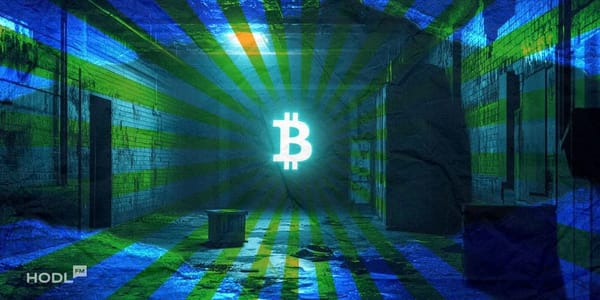Bitcoin Runes launched with great fanfare during the halving event on April 20, 2024. The new protocol pushed Bitcoin transactions to new highs, driving miner revenue to record levels.
Related: Top 10 Cryptocurrencies Of May 2024
However, the hype turned out to be unsustainable, as Runes’ relevance plummeted in a matter of days, leaving Bitcoin investors with a bitter taste.

What Is the Runes Protocol?
Runes Protocol is a standard that lets you create other tokens on the Bitcoin blockchain. If you’re new to Bitcoin, you may wonder how that is possible, as Bitcoin doesn’t support the smart contract feature.
Well, crypto nerds found other ways. As you may know, each Bitcoin is split into 100 million satoshis, and there is a way to create other tokens by inscribing these satoshis and tracking them.
It’s akin to signing your autograph on USD banknotes – if you’re a celebrity, those bills have a different value.
This practice of scribbling satoshis started with the Ordinals Protocol, which opened the door to so-called Bitcoin non-fungible tokens (NFTs). Ordinals have also been used as the basis for the experimental BRC-20 standard, which lets you create fungible tokens on Bitcoin.
BRC-20 tokens have a market cap of $2 billion as of this writing, while Bitcoin NFTs have outperformed Ethereum and Solana NFTs by trading volume.
Ordinals have made much noise, so why was Runes needed at all? The answer is very technical, but long story short, the new protocol makes it much easier and more efficient to mint fungible tokens on Bitcoin.
Both Ordinals and Runes protocols are the brainchildren of blockchain developer Casey Rodarmor.
Why Is Runes Better than Ordinals?
There are many reasons for this. The goal of Runes is to simplify the token creation process while reducing the on-chain footprint.
Unlike Ordinals, Runes adopts the Unspent Transaction Output (UTXO) model for better efficiency. Also, Runes rely on the OP_RETURN optcode to store up to 80 bytes of data on BTC transactions. Thanks to these adoptions, Runes makes it easier to create fungible tokens directly on-chain without impacting Bitcoin performance.
The process of generating a new Rune is called etching, where users specify the name, ID, symbol, supply, and divisibility of the new tokens. Eventually, Runes can be minted through open or closed mints that enable the creation of new tokens when predetermined conditions are met. Closed mints were not possible with Ordinals.
Thanks to these improvements in design, the market had high expectations of Runes. Asset manager Franklin Templeton said in a report:
Currently the fungible token market for Bitcoin is quite small in comparison to ETH and SOL; however, with the launch of more efficient token standard (Runes), Bitcoin is positioned well to to close the gap between its fungible market cap versus that of other blockchains.
Runes Drive Bitcoin Activity to New Highs
Indeed, Runes changed the face of Bitcoin for about two weeks. They said Bitcoin was not boring anymore, as if the oldest cryptocurrency was designed for entertainment.
Shortly after the launch of Runes, Bitcoin daily transactions surged on April 23 to a record 927 thousand.

For about two weeks, Runes accounted for a good chunk of all Bitcoin transactions, and its share exceeded 50% on several occasions, according to data shared via Dune.
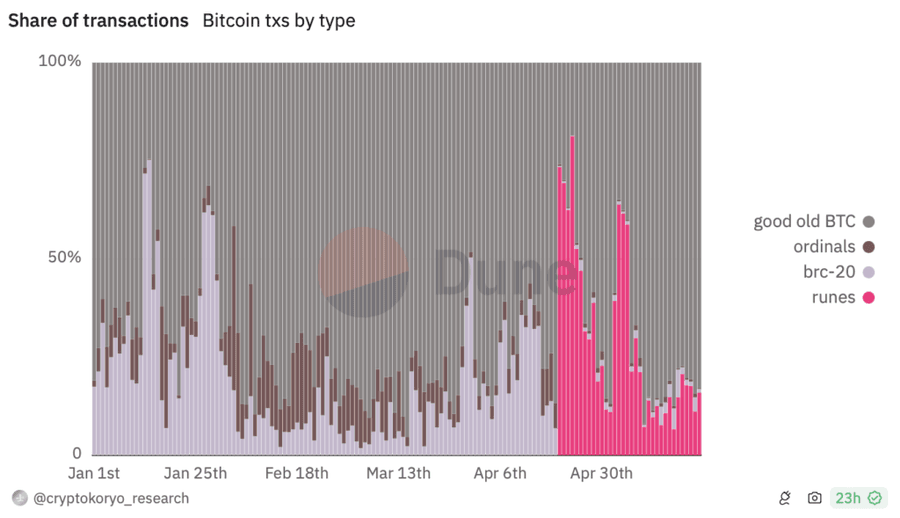
Many investors were happy about the launch of Runes, but the real winners were miners. While the halving event reduced the mining reward to 3.125 BTC per block, miners hit the jackpot with the Runes protocol.
On April 20, Bitcoin transaction fees hit a record $127.97, which is about seven times more than the fee rate on the previous day and about 100% higher than the previous record.
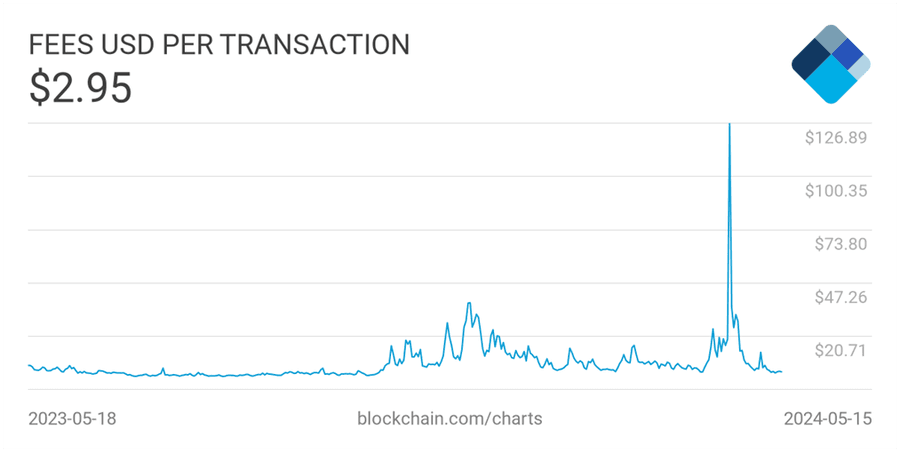
The money flooded, with miner revenue hitting a record $107 million on that day. Transaction fees accounted for about 75% of all mining revenue.
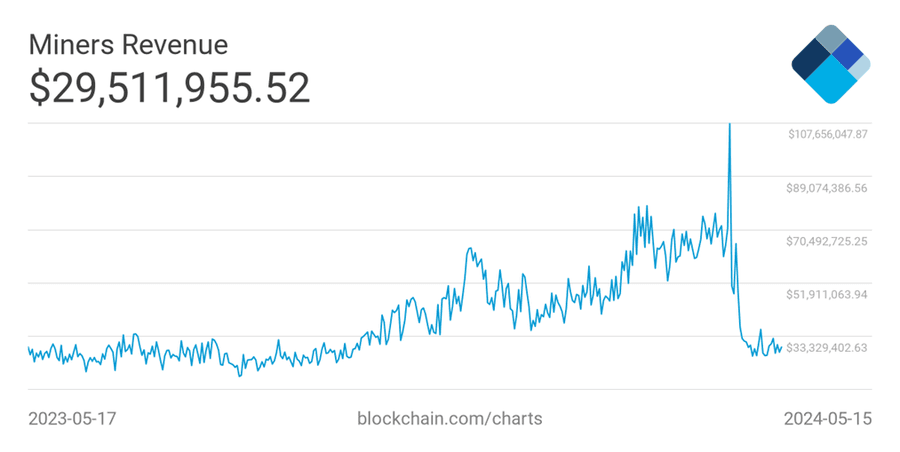
The hype around Runes was so intense that many believed it was Bitcoin’s “DeFi summer” moment. Gautam Chhugani and Mahika Sapra of brokerage firm Bernstein stated in a note to investors:
Bitcoin is experiencing a ‘Defi summer’ like moment that Ethereum did back in 2020, where multiple decentralized apps and tokens were launched on the Ethereum blockchain, leading to splurge of liquidity and transaction fees.
The Reality Slap
Despite the promising start, the Runes party has quickly faded. The previous charts have already provided the spoiler, showing the dramatic decline in transaction fees and miner revenue. On May 8, miner revenue hit the lowest level since mid-October 2023.
It’s hard to treat it as a healthy correction, as Runes activity has collapsed by 99.9% from its recent peak.
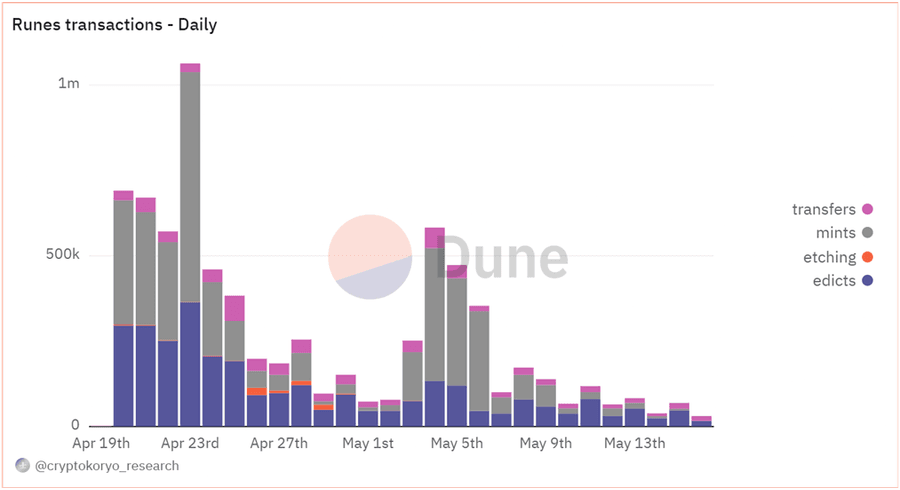
Today, there are almost 70,000 token projects etched with the Runes Protocol. The majority of them came shortly after the protocol’s launch, and the interest in creating new tokens has dropped.
The overwhelming majority of Runes are meme coins. Obviously, the lion’s share of them don’t deserve a penny, being typical sh**coins.
The hope that Bitcoin was about to build a meme coins ecosystem similar to that of Ethereum or Solana turned out to be unattainable.
Will Runes Provide Any Opportunity in the Future?
The Runes Protocol went from hero to zero in a matter of days, but does it still hold potential? Remember how CryptoKitties made waves and then became dormant before the NFT hype in 2021? Will the Runes protocol revive at a later date?
After such a rollercoaster, it’s difficult to make accurate predictions, but at least we know that Runes offers the most efficient way to create tokens on Bitcoin. Is this bullish take enough to secure future relevance? The truth is that crypto developers would still consider Ethereum, Solana, and other PoS chains over Bitcoin due to their high performance.
Interestingly, a DeFi researcher, going by the pseudonym Ignas, said before launch that the real market opportunity for Runes would show up months after the first wave of hype goes away.
Runes is here to stay – not just for one more wave, but many more to come.
Disclaimer: All materials on this site are for informational purposes only. None of the material should be interpreted as investment advice. Please note that despite the nature of much of the material created and hosted on this website, HODL FM is not a financial reference resource and the opinions of authors and other contributors are their own and should not be taken as financial advice. If you require advice of this sort, HODL FM strongly recommends contacting a qualified industry professional.



